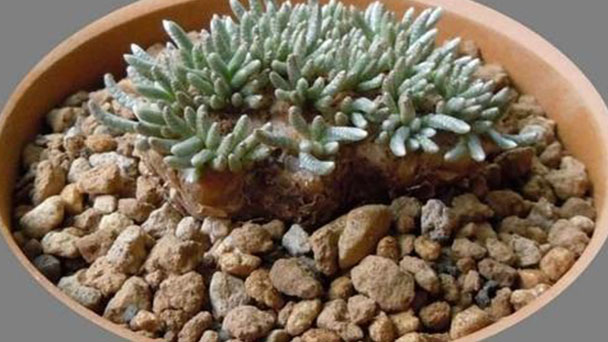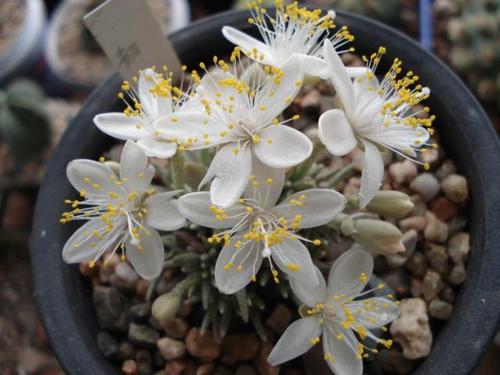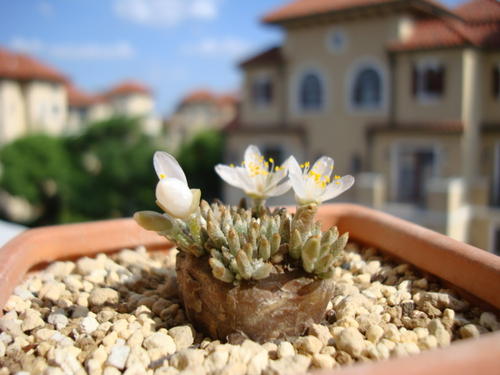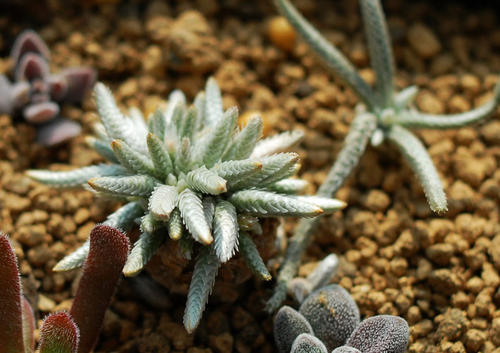Anacampseros alstonii profile
Written by Maggie
Feb 23 2021

Anacampseros alstonii is a succulent, root-tuber perennial plant with white and red flowers in the genus Anacampseros alstonii.
Anacampseros alstonii is native to the desert areas of South Africa and Namibia. Its peculiar form, the tiny branches and the rhizomes of primitive simplicity set each other off becomes an interest, like a pick on the rock stone sea anemones, and like a dancing measure, and the small plant type, slow growth, like living arts and crafts, suitable for small basin planting, put in the place such as sunlight, windowsill, watch carefully, in your spare time to appreciate its magic charm.
Anacampseros alstonii picture

Morphological characteristics of Anacampseros alstonii
Anacampseros alstonii is a variety of anacampseros alstonii, as well as Carthamus alstonii, a succulent perennial root tuber with white and red flowers in the genus Anacampseros in the Portulaca family.
Anacampseros alstonii is native to the desert areas of South Africa and Namibia. Anacampseros alstonii likes a cool, dry and sunny environment. It is resistant to drought, afraid of standing water, and also afraid of hot and humid, slightly cold. Anacampseros alstonii flowers were plum blossom, at the top of the twigs, about 2 centimeters in diameter, stamens longer, often more than the petals, the top of the golden anther, petals silk, white.
The flowering period of Anacampseros alstonii is less than 2 hours, because of its short flowering period, coupled with the introduction of the plant in China is not long, cultivation is not too common, few people have seen its flowers. Anacampseros alstonii usually blooms in the sunny afternoon and closes at night. The life of each flower is only 4 ~ 5 hours. If it is overcast and rainy or the cultivation environment is not adequately illuminated, it is difficult to open.
Ecological habits of Anacampseros alstonii
Anacampseros alstonii likes a cool, dry and sunny environment, drought resistance, afraid of water, but also afraid of hot and humid, slightly cold, winter into the indoor winter, the temperature should not be lower than 5 degrees Celsius.
Anacampseros alstonii likes a cool, dry and sunny environment, drought and half shade, avoid water wet and strong light, but also afraid of hot and humid, slightly cold. The suitable growth temperature is 20~25℃, and the growth period is summer.
How to grow and care for Anacampseros alstonii
In the basin
Repot every spring for Anacampseros alstonii. The basin soil should be well-drained and kept slightly dry. Summer high-temperature strong light should be appropriate shade.
Watering
In the Anacampseros alstonii growing period every 2 weeks 1 time, fleshy stem base swelling, tuber shape, water should not be much, dry weather to the pot around the spray, do not spray water to the stem and leaves. In winter, the room temperature is low, and the basin soil keeps dry.
Fertilization
In the Anacampseros alstonii growth period fertilizes 1 times a month, with the special use of succulent fertilizer.Fertilizer must not stain the leaf surface.
Light
Anacampseros alstonii likes sunshine and is a full sunshine plant.

The propagation of Anacampseros alstonii
Home conservation of Anacampseros alstonii uses sowing and cutting propagation methods.
Sow
In spring, indoor pot sowing was used, the germination room temperature was 20-25 ℃, and 15 to 21 days after sowing.
Cuttings
In spring, cut the strong top stems of Anacampseros alstonii, 3 to 4 cm long, dry them a little, then insert them into the sand bed, keep the soil slightly dry, and root for 21 to 27 days after planting.
Disease control of Anacampseros alstonii
Anacampseros alstonii common diseases and insect pests are anthrax, scale insect.
The distribution of Anacampseros alstonii
Anacampseros alstonii is native to the desert areas of South Africa and Namibia.
Species classification of Anacampseros alstonii
Other similar species in the genus Rumei are silver silkworm and snow goddess.
The silver silkworm (A. albissima), also known as the dance of the goblins, has A large fleshy short stem, A cluster of fine circular branches, and A surface densely covered with scaly spiral-shaped leaflets.
A. Papyracea, also known as White Snake Dian, has a short fleshy stem, fat and branched at most, which is inclined or curved and extends to the ground. The stem surface is covered with scaly white paper leaflets, and the top of the stem is covered with small white and green flowers.

Latest Updated
- Benefits of Bugleweed - 7 Science-backed Health Benefits
- Bugleweed Dangers & Side Effects - Is It Poisonous?
- How to Plant Evergreen Trees - What You Should Know
- When to Plant Evergreens - Grow Guide for Evergreen Trees
- 12 Wonderful Evergreen Shrubs for Your Garden
- 12 Popular Evergreen Plants with Pictures for Beginners
- When And How To Prune A Lilac Bush Like a Pro
- How to Grow & Care for Lilac Vine (Hardenbergia Violacea)
- Japanese Lilac Tree (Syringa Reticulata) Care & Propagation Guide
- Shumard Oak Pros and Cons - What to Know
Popular Articles
- Winter maintenance of Antirrhinum Majus
- How to Grow Terminalia Mantaly Tree
- How to Grow and Care for Crossostephium Chinense
- How to grow Antirrhinum Majus in spring
- Peristeria Elata (Dove Orchid) Profile: Info & Care Guide
- Underwatered Snake Plant (Sansevieria Trifasciata) - Signs And How To Fix
- How to Care for Brazilian Jasmine Plant (Mandevilla Sanderi)
- How to Grow & Care for Graptopetalum Purple Delight in Summer
- Rosa Chinensis (China Rose): Plant Growing & Care Tips
- How to Care for Baby Sun Rose (Aptenia Cordifolia)